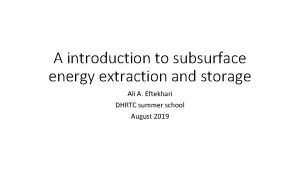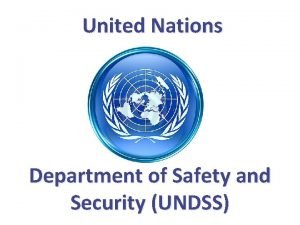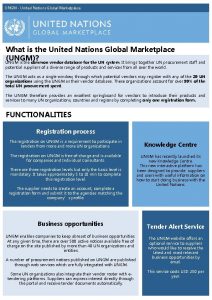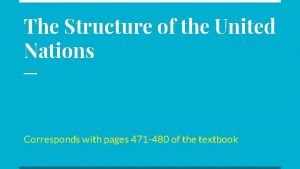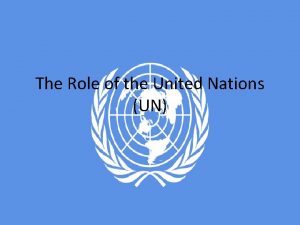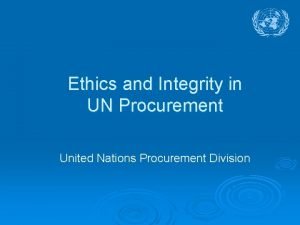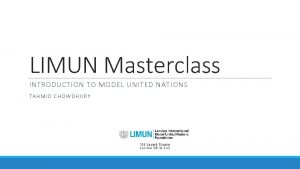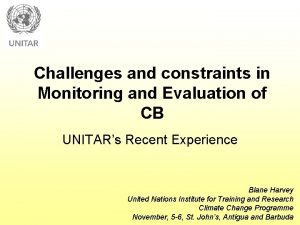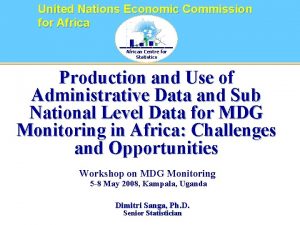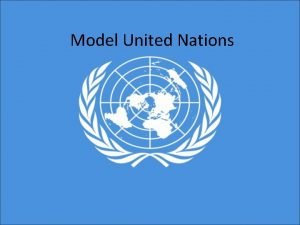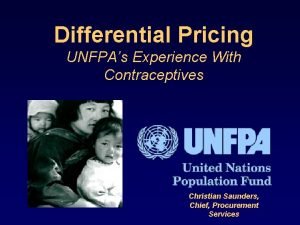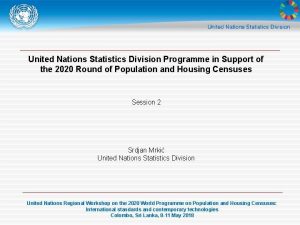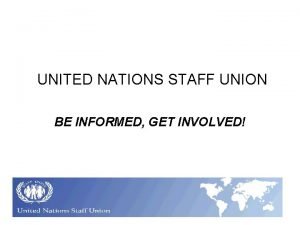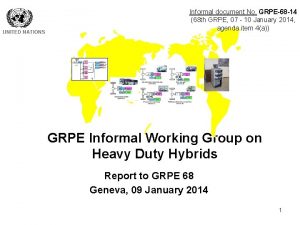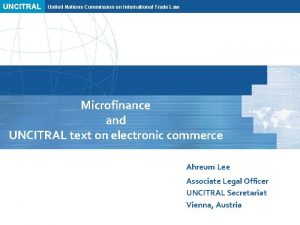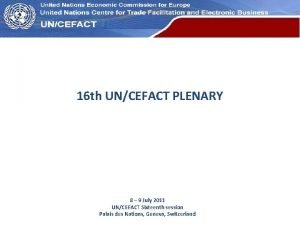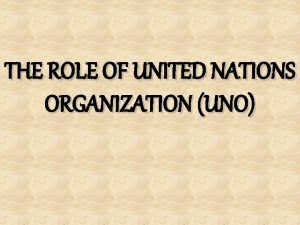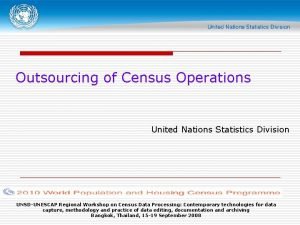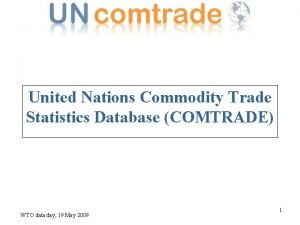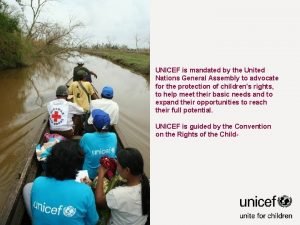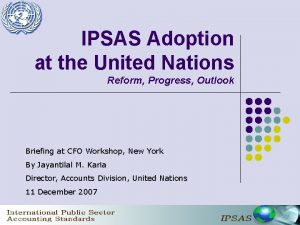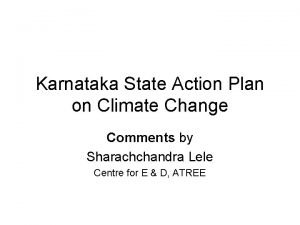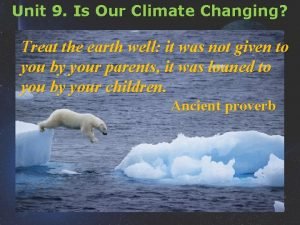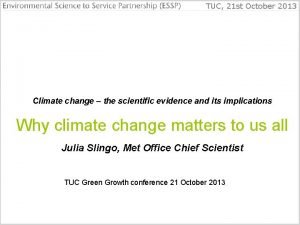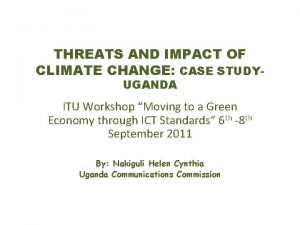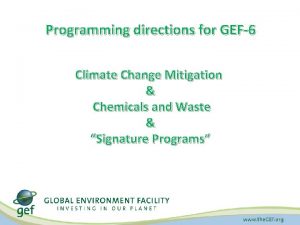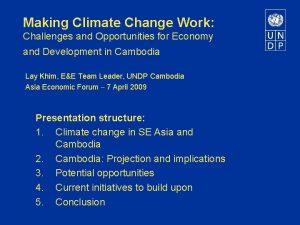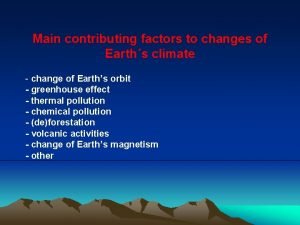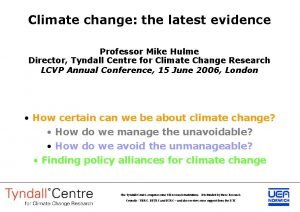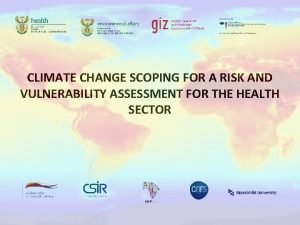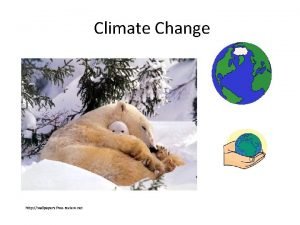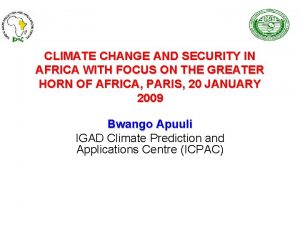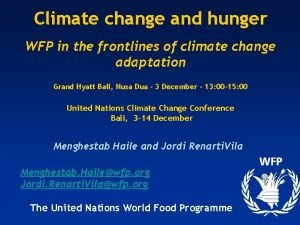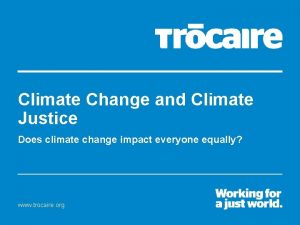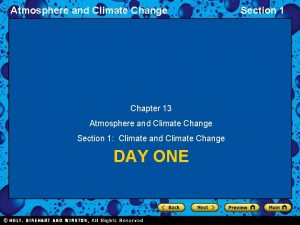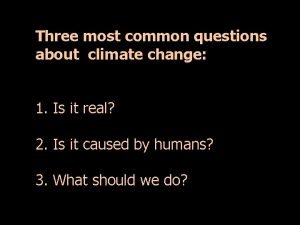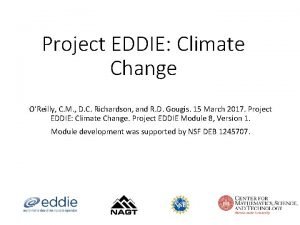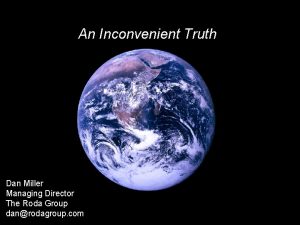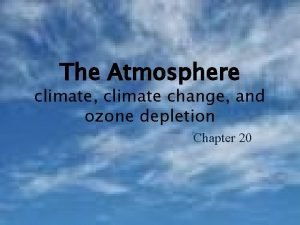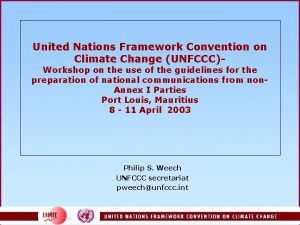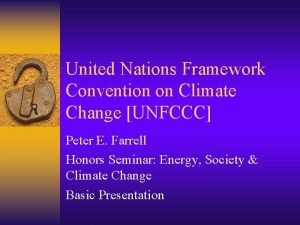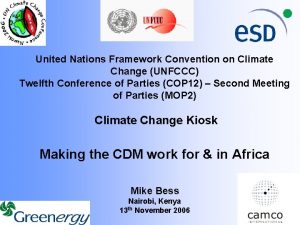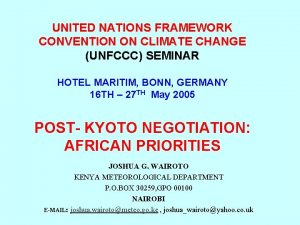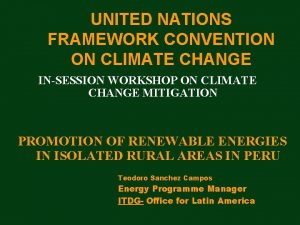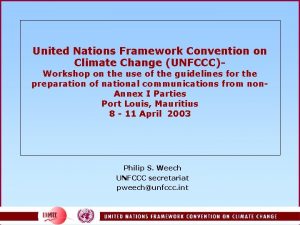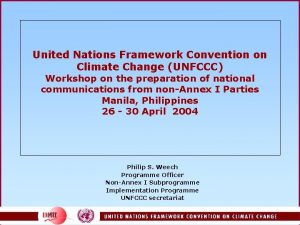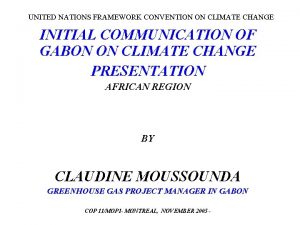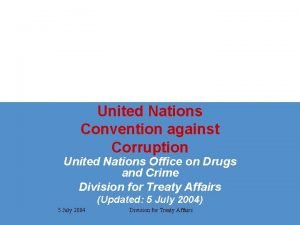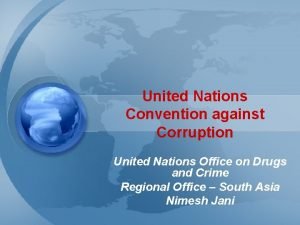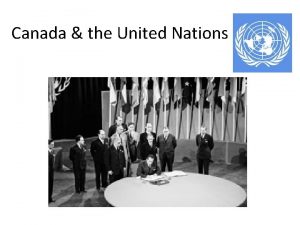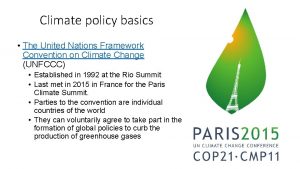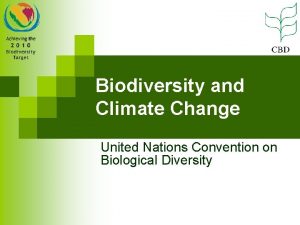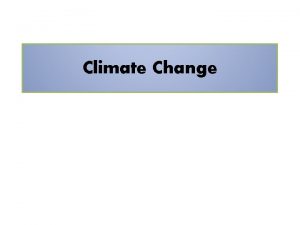UNITED NATIONS FRAMEWORK CONVENTION ON CLIMATE CHANGE COP


































































- Slides: 66

UNITED NATIONS FRAMEWORK CONVENTION ON CLIMATE CHANGE COP 21 VENUE: PARIS, FRANCE

PARTICIPATION STATISTICS State/Organizations Participants 186 6291 2 (Palestine and Holy See) 5 UN Secretariat units and bodies 30 245 Specialized agencies and related organizations 19 197 Intergovernmental organizations 53 439 Non-governmental organizations 624 3104 Media 434 904 Parties Observer States Total 11185

IMPORTANT POINTS IN THE AGREEMENT • • Differentiation Long-Term Goal Mitigation Carbon Markets Transparency and Support Finance Adaptation Loss and Damage


Differentiation • The agreement includes references to developed and developing countries, stating in several places that the former should take the lead. • Many provisions establish common commitments while allowing flexibility to accommodate different national capacities and circumstances - either through selfdifferentiation, as implicit in the concept of nationally determined contributions, or through more detailed operational rules still to be developed.

Long-Term Goal The agreement reaffirms the goal of keeping average warming below 2 degrees Celsius, while also urging parties to “pursue efforts” to limit it to 1. 5 degrees, a top priority for developing countries highly vulnerable to climate impacts.

Mitigation • With respect to countries’ individual mitigation efforts, the agreement prescribes a set of binding procedural commitments: • To “prepare, communicate and maintain” a NDC (Nationally Determined Contributions) • To provide information necessary for clarity and transparency; and to communicate a new NDC every five years. • It also sets the expectation that each successive NDC will “represent a progression” beyond the previous one and reflect a party’s “highest possible ambition. ” • Developed countries “should” undertake absolute economywide reduction targets, while developing countries “are encouraged” to move toward economy-wide targets over time. In addition, developing countries are to receive support to implement their commitments.

Carbon Markets • While avoiding any direct reference to the use of market based approaches – a concession to a handful of countries that oppose them – the agreement recognizes that parties may use “internationally transferred mitigation outcomes” to implement their NDCs. • It requires that parties engaging in such transfers ensure the “avoidance of double counting, ” consistent with accounting guidelines for NDCs to be developed.

Transparency and Support • All countries are required to submit emissions inventories and the “information necessary to track progress made in implementing and achieving” their NDCs. • The COP decision says that, with the exception of least developed and small island countries, these reports are to be submitted at least every two years. • In addition, developed countries “shall” report on support provided; developing countries “should” report on support received; and all “should” report on their adaptation efforts.

Finance • The agreement commits developed countries to provide finance for mitigation and adaptation in developing countries (“in continuation of their existing obligations under the Convention, ” a stipulation sought by the United States so the agreement would not create new binding financial commitments requiring congressional approval). “Other” parties are “encouraged” to provide such support “voluntarily. ” The COP decision extends the $100 billion-a-year goal through 2025, and beyond that, says only that by 2025 the COP will set a “new collective quantified goal from a floor of” $100 billion a year.

Finance • Biennially, developed countries should report the status of their help to developing countries in terms of climate finance, and mitigation and adaption. • Global stocktake should collect the information regarding the dealings of climate finance. • The report submitted by developed countries should be transparent and consistent. • In the context of national climate strategies and plans of least developed or developing countries, The Financial Mechanism of the Convention should aim to ensure easy approval procedures and ready support.

Adaptation • Establishing a global goal of “enhancing adaptive capacity, strengthening resilience and reducing vulnerability to climate change; ” • Requiring all parties, “as appropriate, ” to plan and implement adaptation efforts; Committing enhanced adaptation support for developing countries; including a review of adaptation progress, and of the adequacy and effectiveness of adaptation support, in the global stocktake to be undertaken every five years.

Loss and Damage • The mechanism, established as an interim body at COP 19, is charged with developing approaches to help vulnerable countries cope with unavoidable impacts, including extreme weather events and slow-onset events such as sea-level rise. • At the insistence of developed countries, led by the United States, the accompanying COP decision specifies that the loss and damage provision “does not involve or provide a basis for any liability or compensation. ”

Civil Society Responses regarding the Paris Agreement

Oxfam International “Developed countries agreed to extend the 100 bn goal through to 2025, after which a new goal will be set for post-2025 finance mobilization, with 100 bn as a floor. It remains unclear if this will be a vague goal that no one can be held accountable to or if it strengthens provisions specifically related to financial support from public sources. Paris has not established an adaptation climate finance target for either pre or post 2020 (either quantitative or qualitatively). Such targets will need to be discussed at COP 22 in Morocco. Paris has been a landmark agreement, but it won’t be the last. ”

WWF “ More immediate steps are needed for the said ambitious action to fight the climate change. Lou Leonard, vice president, climate change says ‘This is a pivotal moment where nations stepped across political fault lines to collectively face down climate change. For decades, we have heard that large developing nations don’t care about climate change and aren’t acting fast enough. The climate talks in Paris showed us that this false narrative now belongs in the dustbin of history. ’

Friends of the Earth “Despite the very favourable reception given by some, Friends of the Earth International believes that the Paris Agreement fails to deliver climate justice. It is a weak agreement where rich countries do not do their fair shares of emissions cuts, or provide their fair share of finance for energy transformation and adaptation for developing countries. There almost no hard numbers or goals within the text to ensure ambitious action on climate change. The part of the text that may have offered redress for vulnerable communities who have suffered irreparable impacts of climate change has been weakened so as to render it ineffective. ”

Climate Justice Campaign “As a first step in implementing the agreement, the UN will host a high-level signing ceremony by world leaders on April 22 next year, followed by a summit meeting of government, business and civil society leaders on May 5 -6. But what was left unsaid was one of the key challenges in fighting climate change: how soon will the international community, and specifically the world’s rich nations and the private sector, succeed in raising the estimated 100 billion dollars per year needed by 2020? ”

Think Tanks’ Responses to The Paris Agreement

HEINRICH BOLL STIFTUNG (HBS) “Judged against low expectations and the collective trauma of Copenhagen 2009, the acceptance of the global and legally binding Paris Agreement on Saturday, 12 th of December, at 19: 26 h, is a historical moment. It achieves a goal long believed unattainable on the long road from Bali (2007) via Durban (2011). It sends a powerful signal that global agreement on such a painful structural transformation is possible. Yet, no government seemed to be willing or able to agree on the specifics. Judged against the enormity of the challenge and the needs and pressure from people on the ground demanding a global deal anchored in climate justice, the Paris Agreement can only be called a disappointment. The gavel in Paris has fallen to seal the deal. But citizens around the world have yet to find out whether the Paris Agreement can be the springboard for lasting policy changes on the ground or whether it will wrap a glorified green veil around the continued inaction of our political

Brookings “A sense of measured optimism and achievement emerged from the Paris climate conference. Diplomats, environmentalists, researchers, and other observers mostly felt relieved after years of discussions toward a new international agreement on climate change. Multilateralism had proven it might be up to the task of addressing climate change. But it’s a very mixed picture, and many of us are still trying to weigh the strengths and weaknesses of the agreement, the structure for global action it has established, and the momentum around climate action it created. As George Monbiot put it in the Guardian: “By comparison to what it could have been, it’s a miracle. By comparison to what it should have been, it’s a disaster. ”

Oxford Climate Policy (OCP) “As regards institutional arrangements and public sector finance, the Paris outcome is clearly weaker than that of Cancun – although, in fairness, there was never any serious expectation that there would be a new fund in the Paris finance package. However, the absence of any figure for public sector funding in the Paris outcome is a genuine step backwards, at least from a recipient perspective. We must be humble and discard the emperor’s new clothes (or, in this case, ‘haute couture’) by admitting that the Paris finance outcome was (lamentably) weak and we should try and look for ways to genuinely enhance the predictability of public sector contributions to international climate finance.

STRUCTURAL VIEW

AGREEMENT FOR CLIMATE TRANSFORMATION

ACT 2015 Partners: ACT 2015 is supported by:

PARIS AGREEMENT’S SEVEN CORE FUNCTIONS 1. Send a clear signal that the low-carbon economy is inevitable 2. Connect the global agreement to the “real economy” and “real people” 3. Provide transparency and accountability 4. Accelerate investment in low-carbon, climate resilient economies 5. Build a basis for climate action that demonstrates fairness 6. Ensure the vulnerable have the capacity to build resilience and adapt 7. Link to science with a sense of urgency IMAGE: NASA

GLOBAL AGREEMENT The package: binding Agreement + decisions + political declaration

CHOICES ON EQUITY Formal process with set criteria? Then how to address equity? Equity framework Yes No Provision of support for developing countries Special LDCs/SIDS treatment Balance (3 cycles + L&D) Types of commitments, robustness and type of information based on capability

ELEMENTS OF MITIGATION (1) • Parties shall prepare, regularly update, and implement mitigation commitments • The ambition of all Parties’ mitigation commitments shall be raised in a continuous mitigation cycle every five years, informed by and informing the adaptation cycle and the support cycle • Developing countries, including, in particular, least developed countries and small island developing States, shall be eligible for support • Least developed countries and small island developing States shall have particular flexibility

ELEMENTS OF MITIGATION (2) • Each Party may at any time submit mitigation commitments that are additional • An independent expert panel is established to undertake individual and global assessments, which will be considered by the MOP • Competent IO and NGOs, and sub-national authorities are encouraged to provide input • Market and non-market mechanisms and new economic mechanism(s) allow for cooperation between Parties

CHOICES ON MITIGATION Setting commitments? Internationally negotiated Nationally determined How to close the gap? What’s the long term goal of the cycle? Long-term goal No roll-back + strengthen Emission reduction target Common accounting Phase out all greenhouse gas emissions to net zero Ex ante assessment Global decarbonization 5 year cycle

ELEMENTS OF ADAPTATION (1) • Shall prepare, regularly update and implement adaptation efforts statements • The adaptation effort shall be enhanced, communicated and updated in a continuous adaptation cycle, informed by the mitigation cycle and the support cycle • The MOP shall consider, every five years, ways to enhance adaption action • The Adaptation Committee shall, upon submission of the adaptation efforts statements, every five years, undertake a review and submit a report

ELEMENTS OF ADAPTATION (2) • Shall aim to ensure the allocation of public finance is balanced (equal allocation) • Developing countries, including, in particular, least developed countries and small island developing States, shall be eligible for support • Relevant international organizations and expert bodies outside the Convention are encouraged to cooperate and invited to report regularly on their actions and activities to achieve the long-term adaptation goal

CHOICES ON ADAPTATION Goal or Goal? No Goal? Quantitative Qualitative Political Parity 5 -year cycle Effort statement 50 -50 finance split Further Enhancement MRV (or M & E) Adaptation committee role NAPs undertaken for different temperature scenarios

CHOICES ON LOSS & DAMAGE Is Loss & Damage Goal or No Goal? in the Agreement? YES NO What is the vehicle? What are the functions? Extend the WIM beyond 2016 Accelerate work under the WIM Compensation regime Additional research and scoping studies or pilots Specific requirements

ELEMENTS OF ADDITIONAL COOPERATIVE ACTION • Parties may prepare, communicate and implement joint agreements to cooperate on actions that represent a progression • These supplementary actions may include non-state actors • Parties may work with other international organizations in pursuit of cooperative action • Guidelines for recognition and contributions by subnational and non-State actors

SUPPORT CYCLE Finance Strategies Inputs: - National reports - Biennial Enhanced Action assessments e. g. scaled up - Reports by finance. financial Institutions - Equity Framework Synthesis of Finance Strategies by SCF Review and Consideratio n by the MOP GOAL: Support mitigation and adaptation goals and shift the agenda

ELEMENTS OF FINANCE (1) • Parties shall shift and scale-up investments for low carbon and climate-resilient development • Developed country Parties shall make financial contributions and mobilize finance at an increasing scale from a floor • Other Parties, regularly determined by the MOP, shall also provide financial contributions • Parties shall improve national policy and institutional frameworks for climate finance

ELEMENTS OF FINANCE (2) • Every five years, until the LTGs are met, the provision of climate finance shall be scaled up as part of a continuous support cycle • Each Party shall prepare and submit finance strategies • Standing Committee on Finance shall prepare and provide, for the MOP a synthesis and aggregate analysis of the strategies • Parties shall work with and through national and international financial institutions in order to align investment decisions and policies w the LTGs

CHOICES ON FINANCE Numbers in the Agreement? Yes No Credible pathway in the Agreement 5 yr cycles Finance strategies Standing committee More MRV Alignment of IFIs with climate objectives Replenishment of the GCF More Parties contribute in the future Support Cycle Finance Cycle Capacity building mechanism Technology development and transfer

CHOICES ON TECHNOLOGY Should we create a new TT mechanism? How do we enhance existing technology transfer? YES Set goals for all Parties in the Agreement NO What kind of goal? How to spend goal? the funding? Increase diffusion of climate technologies Increase public funding for R&D Create specific commitments for developed country Parties Enhance national enabling environments

CHOICES ON CAPACITY BUILDING Should we create a new CB mechanism? What should be its focus or function? YES NO How to spend the funding? Monitoring and review of efforts and support Provide advice and guidance Enhance institutional and legal framework Adequate and dedicated financial support

COMMONALITIES AND DIFFERENCES BETWEEN THE CYCLES What is common 5 -year cycle What is different Mitigation Submissions every 5 Mitigation years i. NDCs/ Commitments Assessment MRV framework + Ex-ante Process additional assessment by Review or Expert Panel Assessment + Consideration by the MOP Reporting National Communications every 4 years Adaptation Efforts Statements Review and recommendations by Adaptation Committee National reports NAPs, NAPAs (no every 2 years frequency) Finance/Support Finance strategies (to include pathways and investment plans) Synthesis assessment by SCF Consideration by the MOP in conjunction with technology & CB National reports every 2 years

ELEMENTS OF TRANSPARENCY AND ACCOUNTABILITY (1) • All Parties shall work towards improving transparency in a continuous and sustained manner over time, taking into account national capabilities and circumstances. No less than existing rules, methodologies and guidelines. • Every two years each Party submits a national report including progress on implementation on mitigation and support • More comprehensive report every four years, that includes information on adaptation efforts and plans • Two-phased assessment • Technical evaluation of individual reports • Multilateral appraisal based on the output of the technical evaluation

ELEMENTS OF TRANSPARENCY AND ACCOUNTABILITY (2) Common Guidelines to be elaborated: • Common global accounting framework that includes the land use sector and transferable emission units • Common methodologies for risk, vulnerability assessments • Common methodologies for tracking and reporting on financial flows

CHOICES ON TRANSPARENCY AND ACCOUNTABILITY How do you improve the system? Is the existing system sufficient? YES NO How do you support developing countries? Same reporting obligations for all countries now Adjust existing reporting obligations based on capabilities/ circumstances Lower their requirements All countries improve, but responsibilities and capabilities vary Enhanced MRV of actions and support Provide financial and technical support

MECHANISM FOR FACILITATING AND PROMOTING IMPLEMENTATION • A mechanism to facilitate and promote implementation, including an implementation committee is established • Non-adversarial and facilitative and shall aim at facilitating and promoting compliance • Procedure triggered by Parties or through assessment process • Shall be able to issue its finding independently & have effective measures available • The MOP, at its first session, shall adopt further modalities and procedures

ELEMENTS OF LEGAL FORM • The package: Binding Agreement + decisions + political declaration • Within the Binding Agreement: • Binding conduct linked to result (implementation of commitments), binding procedures (MRV) • Tools for Robustness/Accountability: • Transparency and Accountability Framework • Compliance (facilitative mechanism)

CHOICES ON LEGAL FORM: ADAPTATION Is the Agreement itself legally binding? Provisions within the Agreement? YES NO Whereare arethe mitigation What kind of effort adaptation How to spend commitments goal? statements located? the funding? located? Legally binding performance e. g. shall achieve In an annex inside the Agreement Legally binding conduct e. g. ‘shall implement’ Shall be publicly recorded as decided by the COP Legally binding procedures e. g. shall maintain, review, update In a registry

CHOICES ON LEGAL FORM: MITIGATION Is the Agreement itself legally binding? Provisions within the Agreement? YES NO the Where are theare mitigation Whatmitigation kind of contributions/commitments How to spend commitments goal? thelocated? funding? located? Legally binding performance e. g. shall achieve In an annex inside the Agreement Legally binding conduct linked to result e. g. ‘shall implement’ Inscribed in a list kept by the Secretariat alongside the Agreement – defined procedures for change Legally binding procedures e. g. shall maintain, review, update In a schedule

THANK YOU ! ACT 2015 Partners: ACT 2015 is supported by:

SPECIFIC PROVISIONS

Section General Main substantive elements and commitments Reporting, review and compliance Institutional arrangements Final articles Provisions Preamble, Article 1 – definitions, Art. 2 – the Agreement’s purpose and Art. 3 – NDCs Art. 4 – mitigation Art. 5 – greenhouse gas sinks and reservoirs and REDD+ Art. 6 – cooperative approaches Art. 7 – adaptation Art. 8 – loss and damage Art. 9 – finance Art. 10 – technology development and transfer Art. 11 – capacity –building Art. 12 – climate change awareness and education Art. 13 – transparency, Art. 14 – global stocktake and Art. 15 – facilitating implementation and compliance Art. 16 – CMA, Art. 17 – secretariat, Art. 18 – SBI and SBSTA, Art. 19 – other bodies and institutional arrangements to serve the Agreement Art. 20 – signature and ratification, Art. 21 – entry into force, Art. 22 – amendments, Art. 23 – annexes, Art. 24 – dispute settlement, Art. 25 – voting, Art. 26 – depository, Art. 27 – reservations, Art. 28 – withdrawal and Art. 29 – languages

General • Preamble: sustainable development, food production, quality jobs, human rights, Mother Earth, “climate justice”, public participation, all levels of government, lifestyles and consumption etc. • Definitions & purpose (Arts 1 & 2): developed, developing country and other Parties; long term temperature goal • Nationally determined contributions in general (Art. 3)

Mitigation • Shall submit increasingly ambitious NDCs every 5 years that are recoded in a public registry (process) • Shall pursue measures with the aim of achieving NDC objectives; ‘bindingness’ of NDCs • Shall provide additional information (Art. 4. 8); account (Art. 4. 13); and provide national inventory and progress reports (Art. 13. 7) at least biennial (decision para. 90) • Support for developing country Parties (Art. 4. 5) but not a precondition • Does not address bunker fuels; forum on the Impact of the Implementation of response measures will serve the Agreement (decision, para. 33); CMA to consider common timeframes (Art. 4. 10); Review of INDCs with 2025/30 timeframes (paras. 23 & 24)

Mitigation contd. Gas sinks/reservoirs and REDD+ (Art. 5) • Conserve and manage emission sinks and reservoirs (Art. 4. 1 d Convention) • Reduce emissions from deforestation and forest degradation in developing countries through existing REDD+ framework • No new mechanism (for payments for ecosystem services) • “non-carbon benefits” = social and environmental safeguards? Voluntary cooperation (Art. 6) • Cooperative approaches to transfer mitigation outcomes • Mechanism to mitigate GHG emissions and support sustainable development (CDM+) • Framework for non-market mechanisms

Adaptation (Art. 7) • Global goal to enhance adaptive capacity, strengthen resilience and reduce vulnerability (7. 1) • Mitigation reduces adaptation efforts (7. 4) • Shall, as appropriate, engage in adaptation planning processes and the implementation of actions (7. 9) • Should, as appropriate, submit and periodically update an adaptation communication on needs, plans and actions (7. 10) as part of e. g. NAPs, NDCs or national communications (7. 11). • Adaptation communications will be housed in a public registry (7. 12). • Adaptation Committee and the Least Developed Countries Expert Group will jointly develop recommendations (decision, para. 41) on modalities to recognise adaption efforts by developing countries - to be adopted @ CMA 1 (Art. 7. 3)

Loss & damage (Art. 8) • Warsaw International Mechanism on loss and damage • Outside support, transparency, stocktake, review and compliance • Task force on displacement related to the adverse impacts of climate change (decision, para. 49) • “Agrees that Article 8 does not involve or provide a basis for any liability or compensation” (para. 51) • State responsibility under public international law

Finance (Art. 9) • Developed countries shall provide financial resources in continuation of existing obligations (Art. 9. 1) as part of a global effort from a wide variety of sources and through a variety of actions (9. 3) • No burden sharing agreement or other binding arrangements • Biennially communicate indicative quantitative and qualitative information (9. 5) and further information on the support actually provided and mobilized (9. 7) • Financial Mechanism of the Convention, including its operating entities – GEF and GCF – will serve as the financial mechanism of the Agreement (9. 8) • Developed countries intend to continue their collective mobilization goal through 2025 (USD 100 billion/year from 2020); CMA will set a new collective quantified goal before 2025 from a floor of USD 100 billion/year (para. 53)

Technology (Art. 10) • Technology framework to guide existing mechanism (Technology Executive Committee and Climate Technology Centre and Network) • Does not address intellectual property rights Capacity building (Art. 11) • Enhance capacity of developing countries to take effective action on mitigation, adaptation, technology development, access to finance, education and reporting • Developing institutional arrangements to be adopted @ CMA 1 (11. 5) Education & awareness raising (Art. 12)

Transparency (Art. 13) • Parties shall report on mitigation effort (13. 7) • Parties should report on climate impacts and adaptation (13. 8) • Developed country Parties shall report on financial, tech transfer and capacity building support; other Parties should (13. 9) • Developing country Parties should report on needs and support received (13. 10) • Technical expert review on mitigation and support, implementation and achievement of NDCs (13. 11 & 12) • Multilateral consideration of progress on finance (13. 11) • Support for developing countries and (13. 14 & 15) and Capacity Building Initiative for Transparency (decision, para. 84)

Stocktake (Art. 14) • Global stocktake on mitigation, adaptation and means of implementation (finance 9. 6, technology transfer 10. 6, no corresponding reference in capacity building) • Implementation of Agreement # implementation of NDCs • Collective progress # individual assessments, but transparency framework to inform global stocktake (Art. 13. 5 & 6) • Sources for global stocktake to be identified – e. g. overall effect of NDCs communicated, IPCC report (decision, para. 99)

Compliance (Art. 15) • Mechanism to facilitate implementation and compliance established • Committee of 12 experts (decision, para. 102) • Modalities and procedures to be adopted @ CMA 1 • No triggers for involvement

Institutional arrangements (Arts 16 -19) • COP serving as the meeting of Parties to this Agreement (CMA) • Convention secretariat (Art. 17) • Subsidiary bodies for scientific and technological advice (SBSTA) and implementation (SBI) • Other bodies or institutional arrangements (Art. 19)

Final articles (Arts 20 -29) • Paris Agreement open for signature at UN Headquarters, New York from 22 April 2016 to 21 April 2017 (Art. 20. 1) • High-level signature ceremony on 22 April 2016 (decision, para. 3) • Entry into force when 55 Parties to the Convention representing 55% of global GHG (Art. 21) deposit instrument of ratification, acceptance etc. • Convention provisions on amendments, annexes and dispute settlement apply “mutatis mutandis” • No reference to the multilateral consultative process on implementation of the Convention (Convention, Art. 13) • Withdrawal (Art. 28) • Provisional application (Decision, para. 5)

General • International (formally binding) treaty building on Copenhagen Accord • Focuses on mitigation and also addresses other areas • COP decision language with some uncertainties • Framework/skeleton agreement • Ad-hoc Working Group on Paris Agreement • Role of the US • NDC implementation => domestic legislation
 Climate change 2014 mitigation of climate change
Climate change 2014 mitigation of climate change United nations convention on the carriage of goods by sea
United nations convention on the carriage of goods by sea Good cop bad cop interrogation
Good cop bad cop interrogation Cop 1 cop 2
Cop 1 cop 2 Example of conceptual framework in accounting
Example of conceptual framework in accounting United nations
United nations United nation department of safety and security
United nation department of safety and security Unmg
Unmg Six main organs of the united nations
Six main organs of the united nations What is the role of the united nations?
What is the role of the united nations? Ethics and integrity at the united nations
Ethics and integrity at the united nations Introduction to model united nations
Introduction to model united nations Constraints in monitoring and evaluation
Constraints in monitoring and evaluation United nations zambia
United nations zambia United nations
United nations United nations
United nations Model united nations
Model united nations The agency sponsored by the united nations that compiles
The agency sponsored by the united nations that compiles Vision and mission of frsc
Vision and mission of frsc Christian saunders united nations
Christian saunders united nations Cold war
Cold war United nations statistics division
United nations statistics division United nations staff union
United nations staff union United nations
United nations Introduction of united nations
Introduction of united nations United nations
United nations United nations economic commission for europe
United nations economic commission for europe Uno flag
Uno flag United nations basic principles on the role of lawyers
United nations basic principles on the role of lawyers United nations statistics division
United nations statistics division Anatolia college mun
Anatolia college mun Un commodity trade statistics database
Un commodity trade statistics database Unicef is mandated by the united
Unicef is mandated by the united Ipsas united nations
Ipsas united nations Opsp united nations
Opsp united nations Unit 2: the united states and canada worksheet answers
Unit 2: the united states and canada worksheet answers Mental wellness continuum
Mental wellness continuum Climate change paragraph
Climate change paragraph Karnataka state action plan on climate change
Karnataka state action plan on climate change Climate types brainpop
Climate types brainpop Climate change meaning and definition
Climate change meaning and definition Atmosphere
Atmosphere Unit 9 climate change
Unit 9 climate change Conclusion of climate change
Conclusion of climate change Youreuropemap.com
Youreuropemap.com Conclusion of climate change
Conclusion of climate change Mathematics of climate change
Mathematics of climate change Globalization definition ap world history
Globalization definition ap world history Climate change mitigation
Climate change mitigation Pc 414
Pc 414 Conclusion of climate change
Conclusion of climate change Factors of climate change
Factors of climate change Conclusion of climate change
Conclusion of climate change Uk climate change
Uk climate change Climate change interview
Climate change interview Factors that affect climate change
Factors that affect climate change Conclusion of climate change
Conclusion of climate change Conclusion of climate change
Conclusion of climate change Climate change causing droughts
Climate change causing droughts Chapter 13 atmosphere and climate change
Chapter 13 atmosphere and climate change Climate change hypothesis
Climate change hypothesis How global warming works
How global warming works Financing education in a climate of change
Financing education in a climate of change Climate change pathos
Climate change pathos Dan miller climate change
Dan miller climate change Un climate change
Un climate change What does rhetorical questions mean
What does rhetorical questions mean



